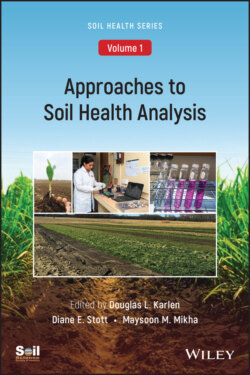Читать книгу Approaches to Soil Health Analysis, Volume 1 - Группа авторов - Страница 15
Interpretation of Soil Health Information
ОглавлениеSeveral nationally appropriate tools, including the Revised Universal Soil Loss Equation (RUSLE), Soil Conditioning Index (SCI), Water Erosion Prediction Project (WEPP), Wind Erosion Prediction System (WEPS), AgroEcosystem Performance Assessment Tool (AEPAT), and Soil Management Assessment Framework (SMAF), have been developed to help interpret soil health related data (USDA‐NRCS, 2019b). RUSLE2 estimates soil loss due to rill and inter‐rill erosion caused by rainfall on cropland (Renard et al., 2011; USDA‐ARS, 2015). The SCI combines information from the soil tillage intensity rating tool (STIR), a N‐leaching index, and Version 2 of the Revised Universal Soil Loss Equation (RUSLE2) to provide information to producers regarding how their management decisions are affecting their soil resources and is widely used in NRCS conservation planning. AEPAT is a research‐oriented index methodology that ranks agroecosystem performance among management practices for chosen functions and indicators (Liebig et al., 2004; Wienhold et al., 2006). Water Erosion Prediction Project (WEPP) is a process‐based, distributed parameter, continuous simulation, erosion prediction model for use on personal computers (USDA‐ARS, 2017); Wind Erosion Prediction System (WEPS) predicts many forms of soil erosion by wind including saltation‐creep and suspension (USDA‐ARS, 2018). Without question, wind‐, water‐, and anthropogenic‐induced soil erosion continues to be a global problem (Karlen & Rice, 2015) and must be the first factor mitigated to truly improve soil health, as it is an advanced symptom of degradation including loss of soil organism habitat, stable aggregation, and other critical soil functions.
Soil health indicator measurements, when coupled with an available assessment framework, complement soil erosion tools as they can directly and more definitively detect less advanced symptoms of soil health degradation across diverse management systems. Laboratory data, without field‐level information can be difficult to interpret or use for management decisions, and should only be used when supplemented with qualitative, in‐field assessments of SH and an understanding of the past and current management system in use.
Data collected over time from the same field can be used to monitor soil health, but this may take a long time to be of value to producers or organizations, as it requires establishing a baseline and sampling over a number of years. Use of soil health assessment frameworks allow single field indicator measurements to be interpreted and used for decision making by leveraging a wealth of research conducted over the last 50 yr and continued targeted data collection. The first such framework (SMAF;) was developed collaboratively between ARS and NRCS (Andrews et al., 2004). Stott et al. (2010) and Wienhold et al. (2009) improved the SMAF by providing additional indicator scoring curves, thus improving its utility for both crop and pasture lands. SMAF uses broad soil taxonomic groups (suborders) as a foundation for assessment and allows curve modification based on inherent soil suborder characteristics. This is often essential as a contextual basis for indicator interpretation.
By design, SMAF assessments are soil‐ and site‐specific, because they depend on soil, climate, and human values such as intended land use, management goals, and environmental sensitivity. A purported SMAF strength is that all of those factors can be manipulated by the user (primarily researchers). This will cause subtle changes in the scoring curves, causing some to argue that is not an advantage because it makes the process too complex for producers and their service providers. The approach taken by the SMAF was thereafter adapted for high throughput, public laboratory soil health testing in New York State by Idowu et al. (2008). The Comprehensive Assessment of Soil Health (CASH) was designed to evaluate soil functioning with respect to crop production and environmental impact and provide producers with a soil health status report similar to soil fertility reports commonly provided by soil testing labs. Most scores are effectively percentile ratings, comparing a measured value to the known population distribution in a soil textural group. CASH was based on the SMAF but used indicator methods with faster analytical procedures to accommodate a high‐throughput lab setting. Furthermore, CASH was originally developed solely for New York, so scoring functions varied by texture, but were not adjusted for any other inherent soil characteristics associated with taxonomic classification or climate.
The framework approach for interpreting measured soil health data is further discussed in Volume 1 (Chapter 5). In summary, both SMAF and CASH provide efficient comparisons of similar soils under diverse management and estimates regarding the level of functioning of a particular field within the overall soil health continuum (van Es & Karlen, 2019). The key to robust interpretations is being able to compare soil samples from both agricultural and non‐agricultural ecosystems, as well as for different soil and crop management practices, using consistent, standard, methods.
